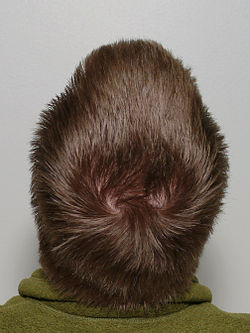Scalp Layers and Structure
- The scalp is composed of five layers: skin, connective tissue, epicranial aponeurosis, loose areolar tissue, and periosteum.
- The skin layer of the scalp is thick and contains numerous hair follicles and sebaceous glands.
- The connective tissue layer provides cushioning and protection.
- The epicranial aponeurosis is a broad, flat tendon that connects the frontalis and occipitalis muscles.
- The loose areolar tissue layer allows for movement and flexibility.
Blood Supply to the Scalp
- The scalp is well-vascularised, receiving blood supply from several arteries.
- The main arteries supplying the scalp are the superficial temporal artery, occipital artery, and posterior auricular artery.
- These arteries anastomose (connect) with each other, providing collateral circulation.
- The blood supply to the scalp is important for maintaining the health and vitality of the hair follicles.
- The scalp also has an extensive venous network that allows for efficient drainage.
Nerve Supply to the Scalp
- The scalp is innervated by branches of the trigeminal nerve (cranial nerve V) and the cervical nerves.
- The trigeminal nerve supplies the anterior and middle parts of the scalp.
- The occipital nerve, a branch of the cervical plexus, supplies the posterior part of the scalp.
- The nerve supply to the scalp is responsible for sensation, including pain, touch, and temperature.
- The scalp also has a rich sensory innervation, making it highly sensitive.
Functions of the Scalp
- The scalp serves as a protective covering for the skull, providing cushioning and insulation.
- It helps regulate body temperature by preventing heat loss from the head.
- The scalp plays a role in the expression of emotions through facial expressions.
- Hair on the scalp provides physical protection from UV radiation and trauma.
- The scalp is an important aesthetic feature and can impact self-image and confidence.
Scalp Disorders
- Scalp disorders include dandruff, scalp psoriasis, seborrheic dermatitis, and scalp folliculitis.
- Dandruff is characterised by flaky skin on the scalp, often caused by an overgrowth of a yeast-like fungus.
- Scalp psoriasis presents as red, scaly patches on the scalp, often accompanied by itching.
- Seborrheic dermatitis is a chronic inflammatory condition that causes redness, itching, and flaking of the scalp.
- Scalp folliculitis is an infection of the hair follicles, resulting in pustules or small abscesses on the scalp.
This article needs additional citations for verification. (January 2019) |
The scalp is the anatomical area bordered by the face at the front, and by the neck at the sides and back.
| Scalp | |
|---|---|
 Illustration depicting the layers of the scalp and meninges | |
 Scalp | |
| Details | |
| Artery | supratrochlear, supraorbital, superficial temporal, occipital |
| Vein | superficial temporal, posterior auricular, occipital |
| Nerve | supratrochlear, supraorbital, greater occipital, lesser occipital, zygomaticotemporal, auriculotemporal |
| Lymph | occipital, mastoid |
| Identifiers | |
| Latin | scalpus |
| MeSH | D012535 |
| FMA | 46494 |
| Anatomical terminology | |
From Middle English scalp, skalp, scalpe (“crown of the head; skull”). Originally a northern word, and therefore probably from a North Germanic source, although the sense-development is unclear; compare Sylt North Frisian Skolp (“dandruff”), Old Norse skálpr (
... Read More